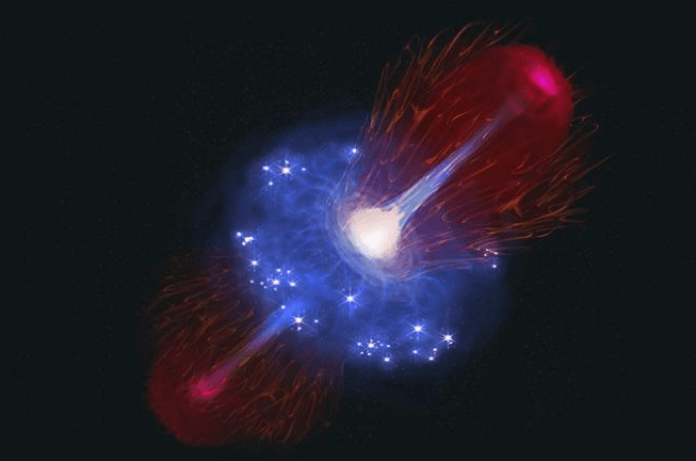Imagine a bear gorging on salmon before curling up for a long winter’s nap, or you crashing on the couch after indulging in a hefty Christmas dinner. Now, imagine a black hole that behaves similarly feeding to an extreme and then slipping into a period of quiet dormancy. This isn’t just cosmic poetry; it’s a reality observed by an international team of astronomers.
Using the NASA/ESA/CSA James Webb Space Telescope (JWST), a team of international astronomers, led by the University of Cambridge, discovered a black hole in the early universe that has overindulged to the point of inactivity. This black hole detected just 800 million years after the Big Bang, is one of the largest ever discovered at such an early stage, clocking in at a staggering 400 million times the mass of our Sun. But here’s the kicker despite its monstrous size, it’s barely consuming any gas, effectively making it a dormant giant.
This discovery challenges everything we thought we knew about how black holes grow and evolve. So, what’s really going on with these early cosmic titans? Are they “born big”? Do they feast in rapid bursts and then snooze for millions of years? Let’s dive into the fascinating mystery of these early monster black holes.
An Early Universe Giant: 40% of Its Galaxy’s Mass
The newly discovered black hole is a cosmic behemoth, making up 40% of its host galaxy’s total mass. To put that in perspective, most black holes in the local universe comprise only 0.1% of their host galaxy’s mass. This discrepancy raises an intriguing question: how did such a colossal black hole form so early in the universe’s history?
The JWST’s observations suggest that standard models may not fully explain the formation and growth of these early black holes. Typically, black holes form from the remnants of dead massive stars and grow by feeding on surrounding gas and dust, up to a predicted limit called the Eddington limit. This limit dictates a black hole’s growth. It is capped by the pressure of radiation pushing away the infalling matter.
Yet, here we are, looking at a black hole that defies these rules.
Dormant, But Not Invisible
Even in its dormant state, this black hole was detectable due to its sheer size. Lead author Ignas Juodzbalis from Cambridge’s Kavli Institute for Cosmology explained, “Even though this black hole is dormant, its enormous size made it possible for us to detect. Its dormant state allowed us to learn about the mass of the host galaxy as well.”
This insight reveals that the early universe was capable of producing these massive black holes even in relatively small galaxies. The discovery also hints that there could be many more of these “napping” giants hiding in the cosmos, waiting to be detected.
Hyperactivity Followed by Long Naps
So, how did this black hole grow so large while spending most of its time dormant? The answer might lie in brief periods of super-Eddington accretion, a phenomenon where black holes temporarily break the feeding limit and grow at hyper-accelerated rates.
According to co-author Professor Roberto Maiolino from the Kavli Institute and Cambridge’s Cavendish Laboratory, “It’s possible that black holes are ‘born big,’ but another possibility is they go through periods of hyperactivity, followed by long periods of dormancy.”
Simulations conducted by the research team suggest that the most likely scenario is that black holes can exceed the Eddington limit for short periods. During this phase they grow very rapidly, followed by long periods of inactivity. The researchers say that black holes such as this one likely eat for 5 to 10 million years and sleep for about 100 million years. It’s like a cosmic feast followed by a long siesta.
Why Are Early Monster Black Holes a Problem?
The existence of such massive black holes in the early universe creates a conundrum for astronomers. According to conventional models, it should take over a billion years for a black hole to grow to the size of millions or billions of solar masses. Discovering black holes of this magnitude just 600 to 800 million years after the Big Bang doesn’t quite fit these timelines.
This inconsistency forces scientists to rethink how these cosmic giants form. Could they be born with a significant amount of mass right from the start? Or do they experience extreme growth spurts that allow them to bypass the usual constraints?
Black Holes That Push the Limits
The Eddington limit isn’t an absolute rule. The JWST’s findings suggest that early black holes might have exceeded this feeding cap for brief periods, allowing them to balloon in size quickly. During these episodes of super-Eddington accretion, the black holes would consume gas at a rate so rapid that radiation pressure temporarily loses the battle against gravity.
“It sounds counterintuitive to explain a dormant black hole with periods of hyperactivity, but these short bursts allow it to grow quickly while spending most of its time napping,” said Maiolino.
Because black holes spend 10 to 20 times longer in dormancy than in hyperactive growth, it’s more likely for astronomers to catch these cosmic titans during their nap time. This makes the discovery of such a massive black hole even more extraordinary.
A Breakthrough in Understanding Early Black Holes
This finding represents a significant breakthrough in our understanding of black hole evolution. The existence of these dormant giants supports the idea that black holes might have grown through a combination of short, intense feeding periods and extended dormancy phases. It also implies that there could be many more undiscovered black holes lurking in the early universe.
“I’m surprised we found this one, but I’m excited to think that there are so many more we could find,” said Maiolino.
If most black holes in the early universe are indeed dormant, detecting them will remain a challenge. However, with the capabilities of the JWST and future telescopes, astronomers are optimistic about uncovering more of these sleeping giants.

